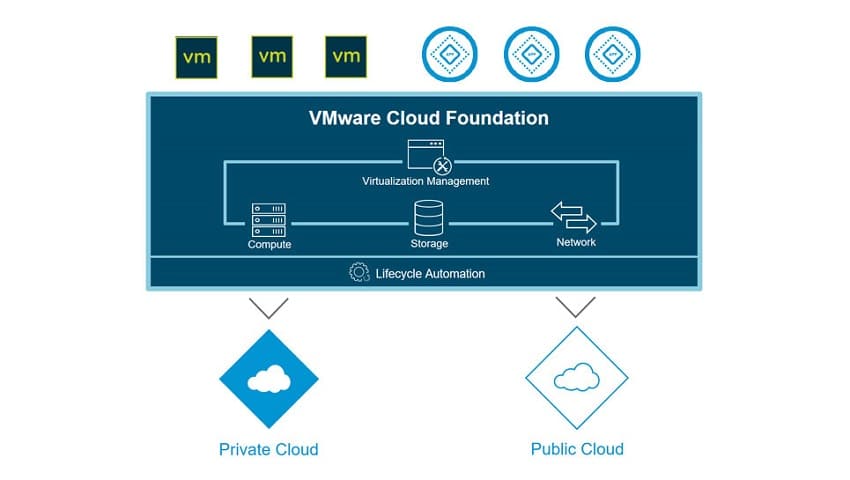Today VMware announced the latest release of its integrated hybrid cloud platform, VMware Cloud Foundation 4.2 (VCF). The latest version is offering improvements across the board in storage, networking, management and security of large-scale virtual machine and container deployments. On top of this, the company is also announcing the availability of the vSAN Data Persistence platform including Cloudian HyperStore and MinIO Object Storage plug-ins.
Read More – VMware Cloud Disaster Recovery Video Demo

First announced way back in 2016, VCF was the company’s unified software-defined data center (SDDC) platform. Initially, it acted as a bedrock for VMware Cross-Cloud Architecture, its early hybrid cloud strategy. VMware Cloud Foundation is still part of the company’s cloud management software. VMware Cloud Foundation 4.2 introduces even more features and enhancements including:
- vSAN Data Persistence platform – Customers can manage S3-compatible object storage for unstructured data with the industry-leading HCI platform, via support for partner offerings from Cloudian and MinIO
- vSAN HCI Mesh – This delivers a unique software-based approach for disaggregation of compute and storage resources. It helps customers reduce CAPEX by sharing capacity across vSAN clusters while lowering OPEX as they reduce the number of storage resources managed by scaling efficiently
- NSX-T 3.1 Federation – This provides a cloud-like operating model for network administrators by simplifying the consumption of networking and security constructs. This includes centralized management, consistent networking, and policy configuration with enforcement, and synchronized operational state across large-scale federated NSX-T deployments. With NSX-T Federation, customers can use stretched networks and unified security policies that span multi-region VMware Cloud Foundation deployments providing workload mobility and simplifying disaster recovery
- SDDC Manager Security Hardening – This feature helps secure communications between SDDC Manager and underlying components to minimize threats to the platform during all operational phases
vSAN Data Persistence Platform
First unveiled in September of 2020, the vSAN Data Persistence platform was said to be a framework for Independent Software Vendors (ISVs) enabling modern stateful services such as object storage and NoSQL databases to integrate with the underlying infrastructure. As stated above, VMware is now working with Cloudian and MinIO to enable users to run their stateful services with increased agility, lower TCO, and simplified operations and management. With the two new partners the platform can now also:
- Allow developers to use Kubernetes APIs to provision and scale stateful services on-demand in a self-service model with minimal administrator intervention
- Deliver integrated service health and capacity monitoring through dedicated dashboards in VMware vCenter Server
- Leverage service-aware infrastructure operations to enable service availability during infrastructure changes including maintenance and lifecycle management
- Run stateful services with optimal storage efficiency
The VMware vSAN Data Persistence platform can be deployed in one of the two following ways:
- Standard vSAN Deployment – this option provides a fast and convenient way to get started running stateful services on vSAN. Customers can run stateful services and traditional apps on the same vSAN cluster to optimize resource utilization. Customers can select the vSAN-SNA (vSAN Support for Shared Nothing Architecture) storage policy to use the availability features that come with stateful service and turns off replication in the vSAN layer for space savings.
- vSAN Direct Configuration – this option allows for stateful service to be deployed on hardware optimized for application needs and use the availability, efficiency, and security features built into the stateful service layer. Additionally, it provides access to the underlying direct-attached hardware for optimal storage efficiency and near bare-metal performance. It also supports hardware on the vSAN Hardware Compatibility List (HCL). In addition, VMware provides recommended hardware configurations that are tested and validated by VMware, Cloudian, MinIO, and select OEM partners for use cases of capacity-optimized object storage and performance-optimized object storage.
The partnership with Cloudian and MinIO brings one more benefit to VMware users, object storage offerings on VCF with Tanzu. Available now and can be purchased directly from the partner companies. Customers can now use:
- Cloudian HyperStore – an enterprise-class, infinitely scalable, multi-tenant storage solution with military-grade security, geo-distribution, and industry-leading S3 API compatibility that supports both modern and traditional applications from a single platform.
- MinIO High-Performance Object Storage – an open-source, Amazon S3 compatible, Kubernetes-native and is designed for cloud-native workloads.
Read More – VMware Cloud Disaster Recovery Video Demo




 Amazon
Amazon